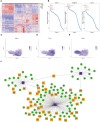Single-cell RNA sequencing reveals different chondrocyte states in femoral cartilage between osteoarthritis and healthy individuals
- PMID: 38868774
- PMCID: PMC11167083
- DOI: 10.3389/fimmu.2024.1407679
Single-cell RNA sequencing reveals different chondrocyte states in femoral cartilage between osteoarthritis and healthy individuals
Abstract
Background: Cartilage injury is the main pathological manifestation of osteoarthritis (OA). Healthy chondrocyte is a prerequisite for cartilage regeneration and repair. Differences between healthy and OA chondrocyte types and the role these types play in cartilage regeneration and OA progression are unclear.
Method: This study conducted single-cell RNA sequencing (scRNA-seq) on the cartilage from normal distal femur of the knee (NC group) and OA femur (OA group) cartilage, the chondrocyte atlas was constructed, and the differences of cell subtypes between the two groups were compared. Pseudo-time and RNA velocity analysis were both performed to verify the possible differentiation sequence of cell subtypes. GO and KEGG pathway enrichment analysis were used to explore the potential functional characteristics of each cell subtype, and to predict the functional changes during cell differentiation. Differences in transcriptional regulation in subtypes were explored by single-cell regulatory network inference and clustering (SCENIC). The distribution of each cell subtype in cartilage tissue was identified by immunohistochemical staining (IHC).
Result: A total of 75,104 cells were included, they were divided into 19 clusters and annotated as 11 chondrocyte subtypes, including two new chondrocyte subtypes: METRNL+ and PRG4+ subtype. METRNL+ is in an early stage during chondrocyte differentiation, and RegC-B is in an intermediate state before chondrocyte dedifferentiation. With cell differentiation, cell subtypes shift from genetic expression to extracellular matrix adhesion and collagen remodeling, and signal pathways shift from HIF-1 to Hippo. The 11 subtypes were finally classified as intrinsic chondrocytes, effector chondrocytes, abnormally differentiated chondrocytes and dedifferentiated chondrocytes. IHC was used to verify the presence and distribution of each chondrocyte subtype.
Conclusion: This study screened two new chondrocyte subtypes, and a novel classification of each subtype was proposed. METRNL+ subtype is in an early stage during chondrocyte differentiation, and its transcriptomic characteristics and specific pathways provide a foundation for cartilage regeneration. EC-B, PRG4+ RegC-B, and FC are typical subtypes in the OA group, and the HippO-Taz pathway enriched by these cell subtypes may play a role in cartilage repair and OA progression. RegC-B is in the intermediate state before chondrocyte dedifferentiation, and its transcriptomic characteristics may provide a theoretical basis for intervening chondrocyte dedifferentiation.
Keywords: cell differentiation; chondrocyte; inflammation; osteoarthritis; single-cell RNA sequencing.
Copyright © 2024 Sun, Yan, Wang, Zhang, Ji, Xiao, Wang and Yu.
Conflict of interest statement
The authors declare that the research was conducted in the absence of any commercial or financial relationships that could be construed as a potential conflict of interest.
Figures






Similar articles
-
Identification of key biomarkers related to fibrocartilage chondrocytes for osteoarthritis based on bulk, single-cell transcriptomic data.Front Immunol. 2024 Nov 21;15:1482361. doi: 10.3389/fimmu.2024.1482361. eCollection 2024. Front Immunol. 2024. PMID: 39640258 Free PMC article.
-
Single-Cell RNA-Seq Reveals Transcriptomic Heterogeneity and Post-Traumatic Osteoarthritis-Associated Early Molecular Changes in Mouse Articular Chondrocytes.Cells. 2021 Jun 10;10(6):1462. doi: 10.3390/cells10061462. Cells. 2021. PMID: 34200880 Free PMC article.
-
Single-cell RNA sequencing reveals distinct chondrocyte states in femoral cartilage under weight-bearing load in Rheumatoid arthritis.Front Immunol. 2023 Aug 16;14:1247355. doi: 10.3389/fimmu.2023.1247355. eCollection 2023. Front Immunol. 2023. PMID: 37654485 Free PMC article.
-
Molecular regulation of articular chondrocyte function and its significance in osteoarthritis.Histol Histopathol. 2011 Mar;26(3):377-94. doi: 10.14670/HH-26.377. Histol Histopathol. 2011. PMID: 21210351 Review.
-
The metabolic characteristics and changes of chondrocytes in vivo and in vitro in osteoarthritis.Front Endocrinol (Lausanne). 2024 May 24;15:1393550. doi: 10.3389/fendo.2024.1393550. eCollection 2024. Front Endocrinol (Lausanne). 2024. PMID: 38854686 Free PMC article. Review.
Cited by
-
Progress in multi-omics studies of osteoarthritis.Biomark Res. 2025 Feb 11;13(1):26. doi: 10.1186/s40364-025-00732-y. Biomark Res. 2025. PMID: 39934890 Free PMC article. Review.
-
Identification and experimental validation of key genes in osteoarthritis based on machine learning algorithms and single-cell sequencing analysis.Heliyon. 2024 Aug 28;10(17):e37047. doi: 10.1016/j.heliyon.2024.e37047. eCollection 2024 Sep 15. Heliyon. 2024. PMID: 39286216 Free PMC article.
-
From cells to clinic: Single-cell transcriptomics shaping the future of orthopedics.J Orthop Translat. 2025 May 28;53:1-11. doi: 10.1016/j.jot.2025.05.001. eCollection 2025 Jul. J Orthop Translat. 2025. PMID: 40510239 Free PMC article. Review.
-
Identification of key biomarkers related to fibrocartilage chondrocytes for osteoarthritis based on bulk, single-cell transcriptomic data.Front Immunol. 2024 Nov 21;15:1482361. doi: 10.3389/fimmu.2024.1482361. eCollection 2024. Front Immunol. 2024. PMID: 39640258 Free PMC article.
-
Insights into chondrocyte populations in cartilaginous tissues at the single-cell level.Nat Rev Rheumatol. 2025 Aug;21(8):465-477. doi: 10.1038/s41584-025-01275-0. Epub 2025 Jul 10. Nat Rev Rheumatol. 2025. PMID: 40640375 Review.
References
-
- Steinmetz JD, Culbreth GT, Haile LM, Rafferty Q, Lo J, Fukutaki KG, et al. . Global, regional, and national burden of osteoarthritis, 1990–2020 and projections to 2050: a systematic analysis for the Global Burden of Disease Study 2021, The Lancet. Rheumatology. (2023) 5:e508–22. doi: 10.1016/S2665-9913(23)00163-7 - DOI - PMC - PubMed
MeSH terms
LinkOut - more resources
Full Text Sources
Miscellaneous

